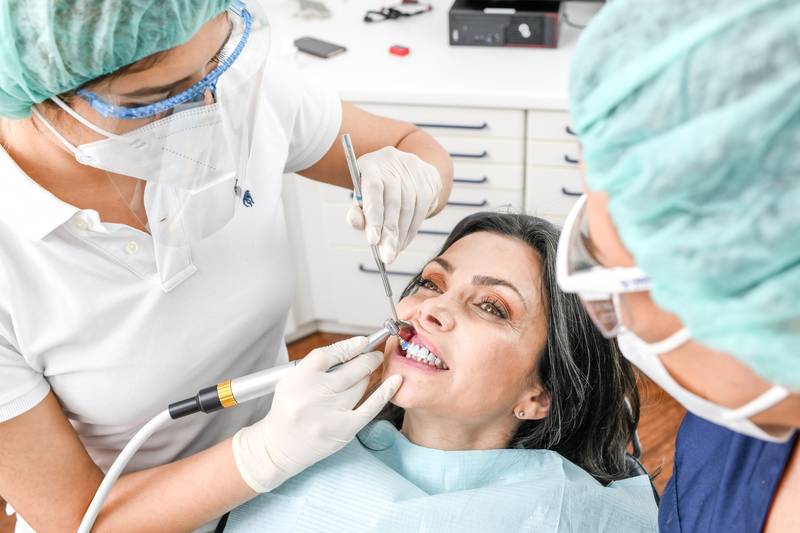Ladies and gentlemen,
It gives me great pleasure to welcome you, on behalf of the Association of German Dental Manufacturers (VDDI), to our press conference concerning the 32nd International Dental Show, to be held in Cologne from 20 to 24th March.
With a total of 1,700 exhibitors and, at the last event, over 77,000 visitors, IDS is indisputably the world’s largest and most comprehensive dental trade fair. It is organised by the Society for the Promotion of the Dental Industry (GFDI) on behalf of the VDDI, and staged by our long-standing and highly capable partner, Koelnmesse GmbH.
I am delighted that you have taken up today’s invitation to find out more about the current economic state of the dental industry in Germany.
The VDDI has been organising IDS since 1923. As of 1992, the show has been held in Cologne, where it has developed, in partnership with Koelnmesse, into a unique innovation platform for the dental industry, where currently around 60 per cent of exhibitors are from outside of Germany. Oliver P. Kuhrt, Executive Vice President of Koelnmesse, will be available afterwards to provide you with all the key figures and details concerning this year’s IDS.
One of the agreeable and long-standing traditions of our press conferences in the run-up to IDS is our custom of inviting the umbrella organisations that represent the two groups immediately responsible for supplying a service to the patient, namely the dentists and the dental technicians. Accordingly, Dr. Oesterreich, Vice President of the German Dental Association (BZÄK), and Mr. Schwichtenberg, Chairman of the Association of German Dental Technicians’ Guilds (VDZI), are also here to present their views on issues related to their sectors and to healthcare policy in general.
First of all, however, let us take a look at last year’s business performance of the German dental industry.
Facts and figures on the German dental industry
The 200 member companies of the Association of German Dental Manufacturers employed a workforce in 2006 of almost 17,500 people both at home and abroad. Although this marks an increase of 1.4 per cent on the previous year, this rise is largely the result of growth abroad, where the number of employees rose by over 14 per cent.
In 2006, VDDI member companies posted a combined turnover of almost €3.5 billion, which represents highly encouraging growth of almost nine per cent. Of that figure, turnover of almost €2 billion was generated abroad, an increase of over 10 per cent.
Forecasts for export business in the current year are largely positive, with 76 per cent of VDDI members expecting turnover to rise, and almost a quarter predicting turnover to remain at the previous year’s level. In other words, not one of our members is expecting export turnover to fall in 2007.
This picture underlines the growing export strength of our industry.
Despite this export boom, our crucial home market here in Germany remains as important as ever. In fact, it bounced back strongly last year following the decline of 2005, which was attributable to the healthcare reforms.
Domestic turnover in 2006 amounted to just under €1.6 billion, an increase of around seven per cent on the figure for 2005.
The outlook for 2007 in the domestic dental market is likewise largely positive, with two-thirds of member companies surveyed forecasting further increases in turnover, and 31 per cent expecting domestic turnover to be at least on a par with last year’s level.
In view of the generally positive signals emanating from the economy as a whole, we believe that such confidence is justified. Not only is unemployment falling, but consumer demand has strengthened and the economy is growing. Against this positive background, we expect the dental industry to profit from this trend and thereby remain on course for growth.
Growth potential in future dental trends
At the same time, the dental industry is able to participate in this economic upswing only because patients are continuing to profit from quality products and services that bring genuine improvements in oral health, with lasting cosmetic and functional benefits. At this year’s IDS, we can once again expect to see a whole range of innovations, of which the following are a small selection:
- A broader range of applications for the advanced ceramic material zirconia, especially in the field of high-quality dental prosthetics
- This is particularly so in conjunction with implants, a major growth market. According to our figures, significantly more than 600,000 implants have been fitted in Germany. The figure has almost doubled over the last four years (2003 to 2006)
- A closer partnership between implantology and periodontics for minimally invasive surgery and a harmonious “red-and-white” cosmetic combination of teeth and gums
- Intelligent electric toothbrushes with a display to provide tips on improved prophylaxis
- New diagnostic procedures using fluorescence measurement to determine an individual’s risk of caries
- New biocompatible alloys with a high gold content for sensitive patients
- Innovative non-precious metal alloys to produce veneer crowns that are even more natural-looking
- Wider use of computer-controlled methods such as CAD/CAM technology to mill crowns and bridges, and of techniques to plan the precise location of implants
- Digitisation of surgery and lab data as well as laser X-ray technology
- The use of digital colorimeters to provide practically foolproof readings of dentition colour
As you can see, the German dental sector — and by that I mean dentists, dental technicians, dental suppliers and the remainder of the dental industry — is well placed to meet all the various wishes of patients.
In order to give a more precise idea of the position of the German dental sector, let me now provide you with a few facts and figures:
Significance of the dental sector within the healthcare system
In Germany, Europe and the world as a whole, the dental sector represents an important and self-contained part of the healthcare market and is, in the medium and long term, a major growth market. According to a U.S. study, the world dental market is currently worth $15 billion and forecast to grow by rates of five to six per cent a year. Engines of growth include an ageing population worldwide, a growing interest in cosmetic dentistry, the fact that people are retaining their own teeth longer and, not least, the increasing standard of living in rapidly growing countries such as China and India. In recent years, we have seen the emergence of extremely interesting markets in these countries, as they are now looking to build up a whole new dental infrastructure.
The domestic market in Germany
In 2004, the German healthcare system employed around 4.2 million people in a total of 800 different jobs and professions, which corresponds to 11 per cent of the total number of employees in Germany. Of that figure, the dental sector accounted for 65,000 dentists, 152,000 dental assistants and 64,000 dental technicians, added to which were 17,500 employees from elsewhere in the dental industry plus those working for the dental trade, neither of which are covered by this statistic. All in all, the dental sector therefore employed around 300,000 people.
In Germany, our domestic market, healthcare spending amounted to around €234 billion in 2004. Of that sum, the statutory health insurers paid a total of €131.6 billion for their insured.
Of the named figure of €147.6 billion, the statutory health insurers paid almost €10.4 billion for dental treatment, including dental prosthetics, in 2006. Dental treatment therefore accounted for 5.2 per cent of total expenditure and dental prosthetics for 1.82 per cent. Although expenditure on dental prosthetics rose in 2006 by 9.7 per cent, this increase must be seen — as already explained — against the background of the substantial decline in 2005.
The private health insurers, who have almost 8.4 million customers, spent €2.4 billion on dental care in 2005, which represented an increase of 5.2 per cent compared to the previous year.
Oral health: A key factor in general health and quality of life
Although dentistry may be said to occupy a special role within the healthcare market as a whole, the German Dental Association and its member organisations rightly underlined once again last year the major importance of prophylaxis and the crucial and incontrovertible link between oral and dental health, on the one hand, and general health, on the other. In fact, they spoke of a paradigm shift in dental care.
In its Global Oral Health Programme, the World Health Organisation (WHO) has recently underscored this connection between oral health and general health. The fundamental objective of the WHO programme is to increase awareness of the importance of oral and dental health as a key factor in general health and the quality of life. The WHO is therefore looking to promote oral health as a overriding medical goal. Among the aims of the WHO action plan, which is scheduled to run until 2020, are to improve the early detection of oral and dental disease as well as of general illnesses in the oral region, particularly in children and the aged; and to increase the importance of prophylaxis and early detection, diagnostic support, and early, minimally invasive treatment.
This opens up the prospect of good growth potential for the dental industry, which in turn justifies the good forecasts for the sector worldwide. Here, we can witness how the idea of comprehensive preventive care to provide early detection and the idea of lifelong dental treatment are spreading to all corners of the globe.
Major trends in the German and international dental markets
Let us now turn to those already emerging trends that will have lastingly positive impact on the market:
- The demographic trend: The world’s population — and not merely in Europe and other Western industrial nations — is increasingly ageing. Demographic trends in Germany, Europe and even Asia all point to the emergence of an ageing society. By the year 2050, for example, the mean age of the German population will have risen from the current figure of 42 to 50 years of age. According to the calculations of the Federal Statistical Office, the number of over 80-year-olds in Germany will rise from four million to 10 million over the same period. Demand for dental products and services, both prophylactic and prosthetic, is therefore set to increase in Germany, Europe and the rest of the world.
- Income and patterns of consumption: The desire to continue enjoying a high quality of life for as long as possible will increase the demand for preventive dental care and specialized forms of lifelong treatment that enable people to retain their teeth until an advanced age so that they can preserve a more youthful appearance.
Forecasts also suggest that the available assets of a substantial proportion of German households are set to increase strongly. Over the coming years, around 15.1 million households (40 per cent of all German households) will inherit a total of €2 billion. We may assume that this section of the population will also invest some of that money on their health and, specifically, oral health.
- Innovation in the dental industry: The manifest technological and scientific advances of the current age will lead to innovations that generate new forms of dental treatment and dental prosthetics, thereby creating substantial growth in, for example, the fields of cosmetic dentistry and implantology. With modern diagnostics and treatment, the chances of preserving teeth and enamel until an advanced age are better than ever. And should dentures nonetheless be necessary, prosthetic dentistry now offers a wide range of options that are closely aligned with patients’ needs for prosthetics that are as close to natural teeth as possible.
- Medical trends are now, as we already noted, towards lifelong treatment in dentistry as well. Today, it is medically and technically possible to preserve a person’s teeth until an advanced age. The recently published fourth German Oral Health Study by the Institute of German Dentists (IDZ) in Cologne revealed two very interesting trends, namely that an emphasis on preventive care by German dentists and the positive attitude towards prophylaxis on the part of the German population has led to a very significant decline in caries, particularly among children and adolescents. On the other hand, the study also shows a substantial increase in figures for periodontal disease in adults and, of course, older members of the population.
- Despite the immense improvements in oral health, particularly amongst the younger generation, the work of dentists, dental technicians and the dental industry as a whole will still be required in the future. If, as is the case, modern approaches to prophylaxis are helping people to retain more of their own teeth into their 50s, 60s and even 70s, then we will naturally see an increased demand for dental care and, ultimately, prosthetics and therefore the services of dental laboratories. This will also include a trend towards fixed dentures, crowns, bridges and implants, with more and more people aged 65 and upwards evidently expressing a preference for this type of dental treatment. In other words, despite all the advances through preventive care, restorative dentistry is set to remain an important factor in maintaining the quality of life.
As you can see, the general conditions are now excellent for the whole of the industry. Together with dentists, dental technicians and the dental trade, we will continue to use our combined energies for the good of the patient. I would therefore like to conclude by inviting you all to attend IDS in Cologne from 20th to 24th March, where you can gain an overview of all the latest innovations from the dental industry during the largest and most comprehensive showcase event worldwide. I would now ask Mr. Kuhrt from Koelnmesse for his statement. Thank you for your attention.
VDDI e.V. – Pressereferat - Burkhard Sticklies Fon: 0221-500687-14 Fax: 0221-500687-21



